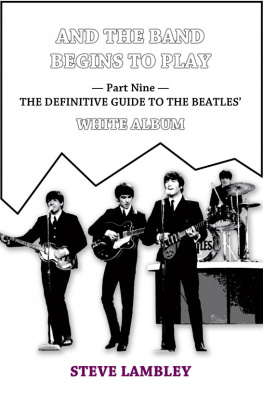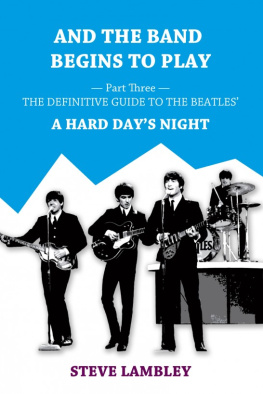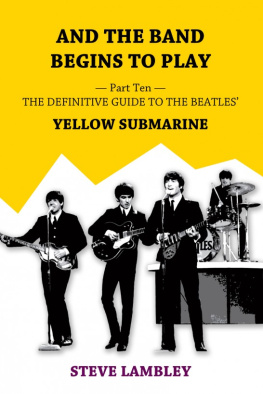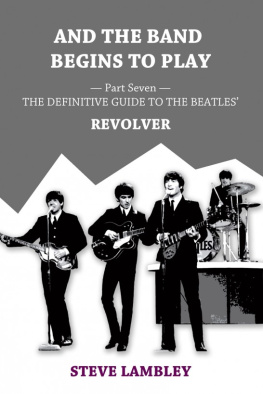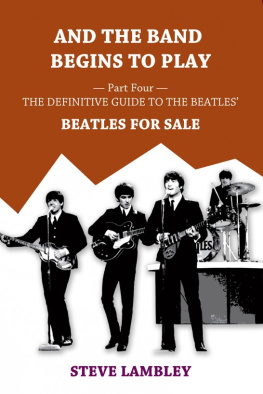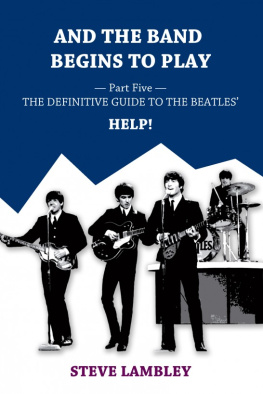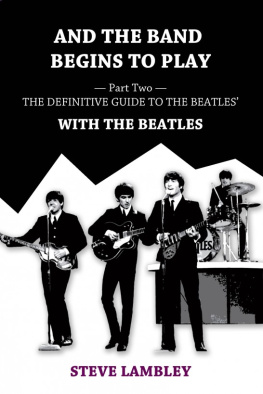AND THE BANDBEGINS TO PLAY
Part Eleven The Definitive Guide to the Beatles LET IT BE
by
SteveLambley
Published bySLIDE Books
Version 2.0
Steve Lambley2015
All song lyricsremain the copyright of their respective owners, and are quoted forthe purposes of scholarship, under fair dealing and fair usagelaws. No infringement is intended.
No part of thisbook may be reproduced in any form without written permission fromthe copyright holder.
SmashwordsEdition, Licence Notes
This ebook islicensed for your personal enjoyment only. This ebook may not bere-sold or given away to other people. If you would like to sharethis book with another person, please purchase an additional copyfor each recipient. If youre reading this book and did notpurchase it, or it was not purchased for your use only, then pleasereturn to Smashwords.com and purchase your own copy. Thank you forrespecting the hard work of this author.
Table ofContents
Single release
AppleR 5777 Released 11 April 1969
Get Back
[Lennon-McCartney]
Recorded 27, 28 January
Mixed 7 April (mono, stereo)
Paul leadvocals, bass
John harmony vocals, lead guitar
George rhythm guitar
Ringo drums
Billy Preston electric piano
Get Back wasthe first single to be recorded at Apple Studios, using the newfacilities installed in the basement of the Apple building at 3Savile Row, London. The recording studio used the innovativetechnique of employing sonic beams to act as baffles and so preventsound from leaking from, for example, the drum kit to the vocalmicrophones. These beams counteracted the sound of the drums byemitting an anti-phase signal that exactly cancelled out theunwanted sound. The studios state-of-the-art recording and mixingequipment also left Abbey Roads antiquated eight-track hardware inthe shade. The Apple control room was equipped with a world-beating72-track mixing desk.
Or at least,that was the intention.
These plans,dreamt up by Magic Alex Mardas, were either scientifically unsound,or, given the technology of the day, totally unfeasible. Mardas hadled the Beatles to believe that the studio would be ready for theirfirst session at the new studio on 20 January, but what he hadproduced by that stage was shoddy and, according to technicalengineer Dave Harries, who was to become studio manager at GeorgeMartins AIR studios, made of bits of wood and an oldoscilloscope. An attempt to record a take brought forth only humsand hisses. Mardass design had apparently even omitted any cablingbetween studio and control room. The basement had to be clearedout, and two four-track mixing desks borrowed from Abbey Road tocomplement Apples eight-track tape machine. Recording was finally possible on 22 January. Acouple of songs recorded on this first day at Apple, Dig A Ponyand She Came In Through The Bathroom Window, were releasedon Anthology3.
The Get Back single was the firstrelease from these so-called Get Back sessions thirty days of filmed rehearsal that, after much soul-searching andextensive problematic delays, ultimately resulted in the LP LetIt Be. Roughly half the sessions, those from 2 to 15 January,took place at the Twickenham film studios. When it became clearthat the Twickenham environment was proving deadly to the groupsability to produce half-decent music, they all decamped to thenewly built Apple Studios to restart the process. The sessionsculminated in the renowned performance on the roof of the Applebuilding on 30 January.
Because ofdifferences between the single and album versions of Get Back,and because it was seen performed on the roof of the Apple buildingin the film Let It Be, there is often confusion aboutexactly what version was recorded when. In fact, the single andalbum versions come from the same take, recorded in Apple Studioson 27 January. This take was preceded by the Rosetta chat thatwas included at the start of the Let It Be LP version, andended with the ooh at the end of that version. The LP then has asnatch of repartee from the rooftop performance, while the singleversion has a coda edited in from a separate take of the trackrecorded on 28 January.
Get Back wasfirst aired at Twickenham on 7 January, in the form of something ofa jam a few lines discernible from the verses, but thedistinctive driving guitar and the chorus firmly in place. It wasalso rehearsed on 9, 10 and 13 January, and was finally brought outfor recording on 23 January, at a session at which Alan Parsonsmade his debut as tape operator. The group ran through severaltakes of the song on most of the subsequent days, and threeversions were performed during the rooftop concert on 30 January.Over-rehearsal naturally resulted in a number of permutations ofthe song. The most notorious, taped on 9 January, included the linedont dig no Pakistanis taking all the peoples jobs. This wasfollowed later that day by a semi-improvised jam that has beenentitled Commonwealth, which included: Youd better get back toyour Commonwealth homes. The songs were outlets for frustration atthe countrys immigration policies and the controversial speech byEnoch Powell in April 1968 warning that unchecked immigration wouldlead to a situation akin to the River Tiber foaming with muchblood. Ludicrously, Paul was accused of racism over leakedrecordings of the session.
There were alot of stories in the newspapers then about Pakistanis crowding outflats you know, living sixteen to a room or whatever. So in oneof the verses of Get Back, which we were making up on the set ofLet It Be, one of the outtakes has something about too manyPakistanis living in a council flat thats the line. Which to mewas actually talking out against overcrowding for Pakistanis If there was any group that was not racist, it was the Beatles We were kind of the first people to open international eyes, in away, to Motown.
Not to mentionthe fact that, two weeks later, Billy Preston was playing along tothe self-same track.
The songepitomises all that the Get Back project stood for. Besideslooking back lyrically to the groups roots, it is also one oftheir simplest songs since Love Me Do, being a blues-basedprogression of GDA (bVIIIVI) (compared to the earlier songsG(D)C, or I(V)IV). But the differences are more interestingthan the similarities. The legendary unsatisfactory drum-work ofthe 1962 track has given way to an excellent, driving performancefrom Ringo, and the knowing simplicity of the request to Love MeDo has become the lyrical duplicity of Get Back.
The release ofthe new single threw up a number of pointers for the record-buyingpublic, giving an indication of the state of the Beatles in thespring of 1969. One apparent pointer was that, given that thegroups last single, Hey Jude, was released the previous August, an eight-month gap seemed tohave opened up between single releases. This misconceptionwas, however, soon allayed by the fact that the follow-up to GetBack was released just seven weeks later. There was also noChristmas single it is true that this had also happened in 1966,but the Beatles had then released Penny Lane/Strawberry FieldsForever in February 1967 and were hard at work on SgtPepper. Get Back was no Penny Lane, and there was certainlyno Sgt Pepper in the offing.
But not onlyhad there been a sizeable gap since Hey Jude, the public also hadto wait almost afortnight for the record to hit the shops. The single hadbeen treated an initial mono mix on 26 March by George Martin,assisted by Jeff Jarratt. (It would be the last Beatles singleissued in mono in the UK conversely, in the US it would be thegroups first single to be issued in stereo.) A further mono mix ofboth Get Back and Dont Let Me Down was carried out by GlynJohns on 4 April, making the official release date of 11 Aprilunattainable. Johns also produced stereo mixes for the US single,due for release on 5 May. But Paul was unhappy with the UK mix ofthe song, and, in spite of an acetate of the single having beenplayed on BBC Radio One by DJs Alan Freeman and John Peel on 6April, he booked Olympic Sound on 7 April to re-mix the track. Thisleft no time for the record to be pressed for the following Friday,and so it finally hit the shops nearly two weeks late. Helped bythis delay, Get Back was the only Beatles single to enter thecharts at number one. It was the last Beatles single to reachnumber one in both the UK and US and in virtually every otherchart across the world. It also won the Ivor Novello Award for thehighest British sales for 1969.
Next page

![Lambley - And the Band Begins to Play: [Part9 The Definitive Guide to the Beatles White Album]](/uploads/posts/book/213743/thumbs/lambley-and-the-band-begins-to-play-part9-the.jpg)
![Lambley - And the Band Begins to Play: [Part1 The Definitive Guide to the Beatles Please Please Me]](/uploads/posts/book/213741/thumbs/lambley-and-the-band-begins-to-play-part1-the.jpg)
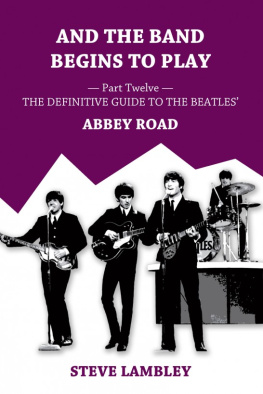

![Lambley - And the Band Begins to Play: [Part6 The Definitive Guide to the Beatles Rubber Soul]](/uploads/posts/book/213742/thumbs/lambley-and-the-band-begins-to-play-part6-the.jpg)
